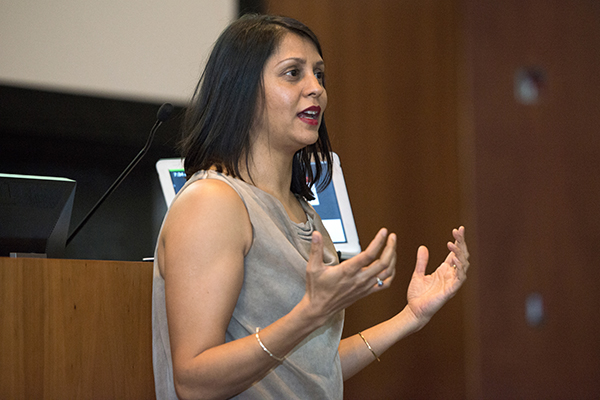

While visiting cousins in India during her youth, Ottaway Professor Sonia Shah was a mosquito magnet.
“Out of all my relatives, I was the one who was getting bit by mosquitos,” Shah said. “I’d have to sleep under a net at night so they couldn’t get to me. They always knew I was an outsider.”
This early encounter is what sparked initial interest in Shah’s research on malaria, which she discussed as part of a lecture in conjunction with her teachings as the 2014 James H. Ottaway Sr. Professor of Journalism at SUNY New Paltz on Tuesday, April 1 in the Coykendall Science Building auditorium.
The lecture, based on her book “Fear: How Malaria Has Ruled Humankind for 500,000 Years,” explored the history of malaria on a global scale and the prevention efforts made in both the past and present.
Shah spent five years researching and writing the book, which was published in 2010. Her research on malaria spawned a successful appearance with TED Talks, which has been viewed by more than 800,000 people since it aired in 2013.
During the lecture, Shah traced back the roots of malaria to the Stone Age and placed emphasis on the disease’s rise in the Roman Empire. Shah said the Romans didn’t know that mosquitos carried the disease and were responsible for spreading it, but they did know that the environment played a factor.
“The Romans knew that something with the air and the humidity was part of the equation in what caused malaria, which is also how the disease got its name,” she said. “‘Mal’ is the Italian word for bad, while ‘aria’ is the word for air, so the literal translation is ‘bad air.’”
Europe and Colonial America also suffered from malaria, Shah said. However, both countries had the resources to rid and further prevent the disease. Shah said that the cure and prevention of malaria had already been discovered by that period.
Even before the synthesis of the chemical pesticide dichlorodiphenyltrichloroethane (DDT) in 1945 was used to combat mosquitos, Jesuit missionaries found the best cure for malaria in Peru during the 1600s.
“Jesuits from Europe who traveled to Peru saw that the Cinchona bark was able to cure the disease so they brought it back with them,” Shah said. “Then in the 1800s, the British doctor Ronald Ross discovered that it was actually mosquitos who carried the disease rather than the air. The answers to curing and preventing malaria have been around for awhile.”
Today, curing and treating malaria is an economic and cultural issue rather than a medical science issue, Shah said.
“People who have it are apathetic to having it,” Shah said. “Communities with a strong presence of malaria see malaria as a part of life. It’s just something that they live with.”
Since the 1950s, several global initiatives worth several billion dollars have been invested in curing malaria. Despite this, three million people are infected with malaria each year, with one million deaths attributed to the disease, Shah said.
While some scientists and doctors believe that malaria on the global scale can be cured by 2015, others believe that we’re nowhere close to finding a cure, Shah said. According to her, it is too early to tell when an accessible cure and the resources to produce it will be found, but that it will eventually be discovered.
It’s just a matter of what Shah calls “political will.”
“In the end, it’s all about finding the political will so that no one else has to die,” she said.
